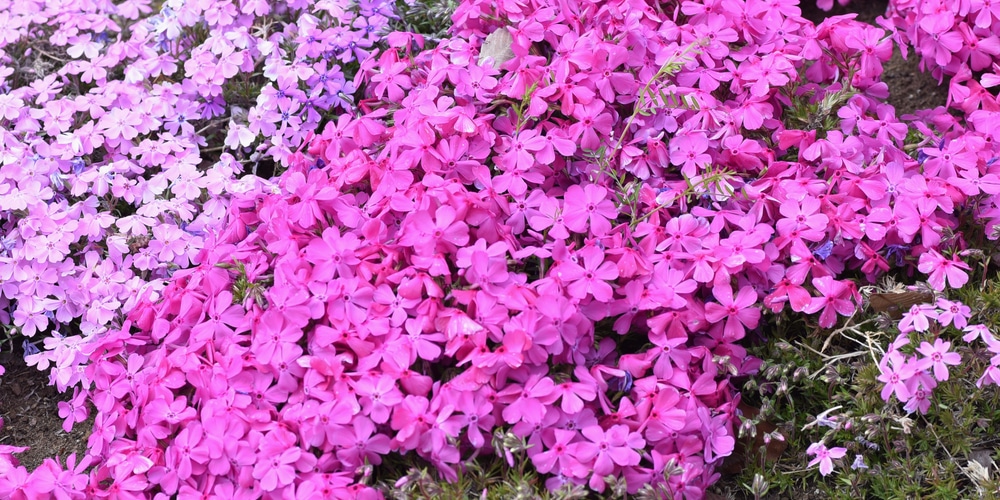Why Divide Creeping Phlox: Boosting Health and Encouraging Growth
Dividing creeping phlox plants is a crucial step in maintaining their health and promoting blooming. By doing so, you can improve air circulation around the roots, reducing the risk of disease and root rot. Additionally, dividing creeping phlox encourages the plant to produce more flowers, as it allows the roots to breathe and absorb essential nutrients more efficiently. This process also helps to prevent overcrowding, which can lead to a decline in plant health and vigor. When done correctly, dividing creeping phlox can revitalize your garden, making it a beautiful and thriving oasis.
Choosing the Right Time: When to Divide Creeping Phlox
Timing is crucial when it comes to dividing creeping phlox plants. The best time to divide creeping phlox depends on various factors, including weather, soil conditions, and plant dormancy. In general, it’s recommended to divide creeping phlox in the early spring or fall, when the plant is dormant. This allows the newly divided plants to establish themselves before the next growing season. Avoid dividing creeping phlox during extreme weather conditions, such as intense heat or cold, as this can cause stress to the plant. Additionally, make sure the soil is moist and well-draining, as this will help the divided plants to settle in quickly. By choosing the right time to divide creeping phlox, you can ensure a successful division and a thriving garden.
Preparing for Division: Essential Tools and Materials
Before diving into the process of dividing creeping phlox plants, it’s essential to gather the necessary tools and materials. Having the right equipment will make the division process smoother and more efficient. Here’s a list of must-haves: garden forks, trowels, gloves, and a sharp, clean knife or pruning tool. Additionally, have some twine or plant ties on hand to secure the divided plants during replanting. It’s also a good idea to have a bucket or container filled with water to keep the roots of the divided plants moist during the process. By having all the necessary tools and materials ready, you’ll be well-prepared to successfully divide your creeping phlox plants and give them the best chance to thrive.
How to Divide Creeping Phlox: A Step-by-Step Guide
Dividing creeping phlox plants can seem intimidating, but with a clear understanding of the process, you’ll be able to successfully divide and replant your phlox. Here’s a step-by-step guide on how to divide creeping phlox plants:
Step 1: Digging – Carefully dig around the creeping phlox plant, making sure to get as much of the root system as possible. Use a garden fork to gently loosen the soil and lift the plant out of the ground.
Step 2: Separating – Once the plant is out of the ground, use a sharp, clean knife or pruning tool to separate the roots and stems. Gently tease apart the roots, working from the bottom up. You may need to use a gentle rocking motion to loosen the roots.
Step 3: Replanting – Replant the divided sections of creeping phlox in well-draining soil, making sure to water thoroughly. Space the new plants about 12-18 inches apart, depending on the variety. Use twine or plant ties to secure the stems and roots during replanting.
By following these steps, you’ll be able to successfully divide and replant your creeping phlox plants. Remember to handle the roots with care, as they can be fragile. With a little patience and practice, you’ll be a pro at dividing creeping phlox plants in no time. When learning how to divide creeping phlox plants, it’s essential to take your time and work carefully to ensure the best results.
Tips for Successful Replanting: Soil, Sun, and Water Considerations
Once you’ve successfully divided your creeping phlox plants, it’s essential to replant them in a way that sets them up for success. Here are some tips to keep in mind for successful replanting:
Soil Preparation – Before replanting, prepare the soil by loosening it to a depth of about 12 inches. Add organic matter such as compost or well-rotted manure to improve drainage and fertility. Creeping phlox prefers well-draining soil, so avoid planting in areas with standing water.
Sunlight Requirements – Creeping phlox plants thrive in full sun to partial shade. When replanting, choose a location that receives at least 4-6 hours of direct sunlight per day. However, if you live in a hot climate, consider providing some afternoon shade to prevent scorching.
Watering Techniques – Water your newly replanted creeping phlox plants regularly, but avoid overwatering. Water at the base of the plant, avoiding the leaves to prevent fungal diseases. During the first few weeks after replanting, keep the soil consistently moist but not waterlogged.
By following these tips, you’ll be able to give your divided creeping phlox plants the best chance to thrive. Remember to handle the roots with care during replanting, and don’t hesitate to reach out if you have any questions about how to divide creeping phlox plants.
Common Mistakes to Avoid When Dividing Creeping Phlox
Dividing creeping phlox plants can be a delicate process, and making mistakes can lead to poor plant health and reduced flower production. Here are some common mistakes to avoid when dividing creeping phlox:
Over-Handling – Creeping phlox roots are fragile and can be easily damaged. Avoid handling the roots excessively, as this can cause stress to the plant and lead to poor growth.
Under-Watering – Newly divided creeping phlox plants require consistent moisture, especially during the first few weeks after replanting. Make sure to water regularly, but avoid overwatering, which can lead to root rot.
Neglecting Soil Quality – Creeping phlox plants thrive in well-draining soil with a pH between 6.0 and 7.0. Neglecting soil quality can lead to poor plant health and reduced flower production. Test your soil regularly and amend it as necessary.
Dividing at the Wrong Time – Dividing creeping phlox plants at the wrong time can cause stress to the plant and lead to poor growth. Avoid dividing during extreme weather conditions, such as during a heatwave or when the soil is waterlogged.
By avoiding these common mistakes, you can ensure that your divided creeping phlox plants thrive and produce an abundance of flowers. Remember to follow the steps outlined in our guide on how to divide creeping phlox plants to achieve the best results.
Aftercare and Maintenance: Ensuring Healthy Growth
After dividing and replanting creeping phlox, it’s essential to provide proper aftercare and maintenance to ensure healthy growth and maximize flower production. Here are some tips to keep in mind:
Fertilization – Feed your newly divided creeping phlox plants with a balanced fertilizer in the spring when new growth appears. This will provide them with the necessary nutrients for healthy growth and flowering.
Pruning – Prune your creeping phlox plants regularly to maintain their shape and encourage bushy growth. Remove any dead or damaged stems, and cut back the plant by about one-third in the spring to promote new growth.
Pest Control – Keep an eye out for pests such as aphids, slugs, and snails, which can damage your creeping phlox plants. Use organic pest control methods whenever possible, such as introducing beneficial insects or using neem oil.
Soil Care – Continue to provide your creeping phlox plants with well-draining soil and a pH between 6.0 and 7.0. Mulch around the base of the plants to retain moisture and suppress weeds.
By following these aftercare and maintenance tips, you can ensure that your divided creeping phlox plants thrive and provide you with years of beautiful flowers and foliage. Remember to follow the steps outlined in our guide on how to divide creeping phlox plants to achieve the best results.
Divided and Thriving: Enjoying Your Revitalized Creeping Phlox
By following the steps outlined in this guide on how to divide creeping phlox plants, you can enjoy a revitalized garden landscape with improved plant health and increased flower production. Dividing creeping phlox is a simple yet effective way to breathe new life into your garden, and with the right techniques and aftercare, you can ensure that your plants thrive for years to come.
One of the most significant benefits of dividing creeping phlox is the increased flower production. By dividing and replanting, you can encourage your plants to produce more blooms, adding color and vibrancy to your garden. Additionally, dividing helps to improve air circulation, reduce disease susceptibility, and promote healthy growth.
With proper care and maintenance, your divided creeping phlox plants will continue to thrive, providing you with a beautiful and lush garden landscape. Remember to fertilize, prune, and monitor for pests to ensure that your plants receive the care they need to flourish.
By mastering the art of dividing creeping phlox, you can enjoy a stunning and vibrant garden that brings joy and beauty to your outdoor space. So why not give it a try? With these simple steps and tips, you can divide and replant your creeping phlox with confidence, and enjoy the many benefits that come with it.



:max_bytes(150000):strip_icc()/creeping-phlox-plants-2132214_04-4b765c75e9d54e9f9292f1b7e610ae7f.jpg)


